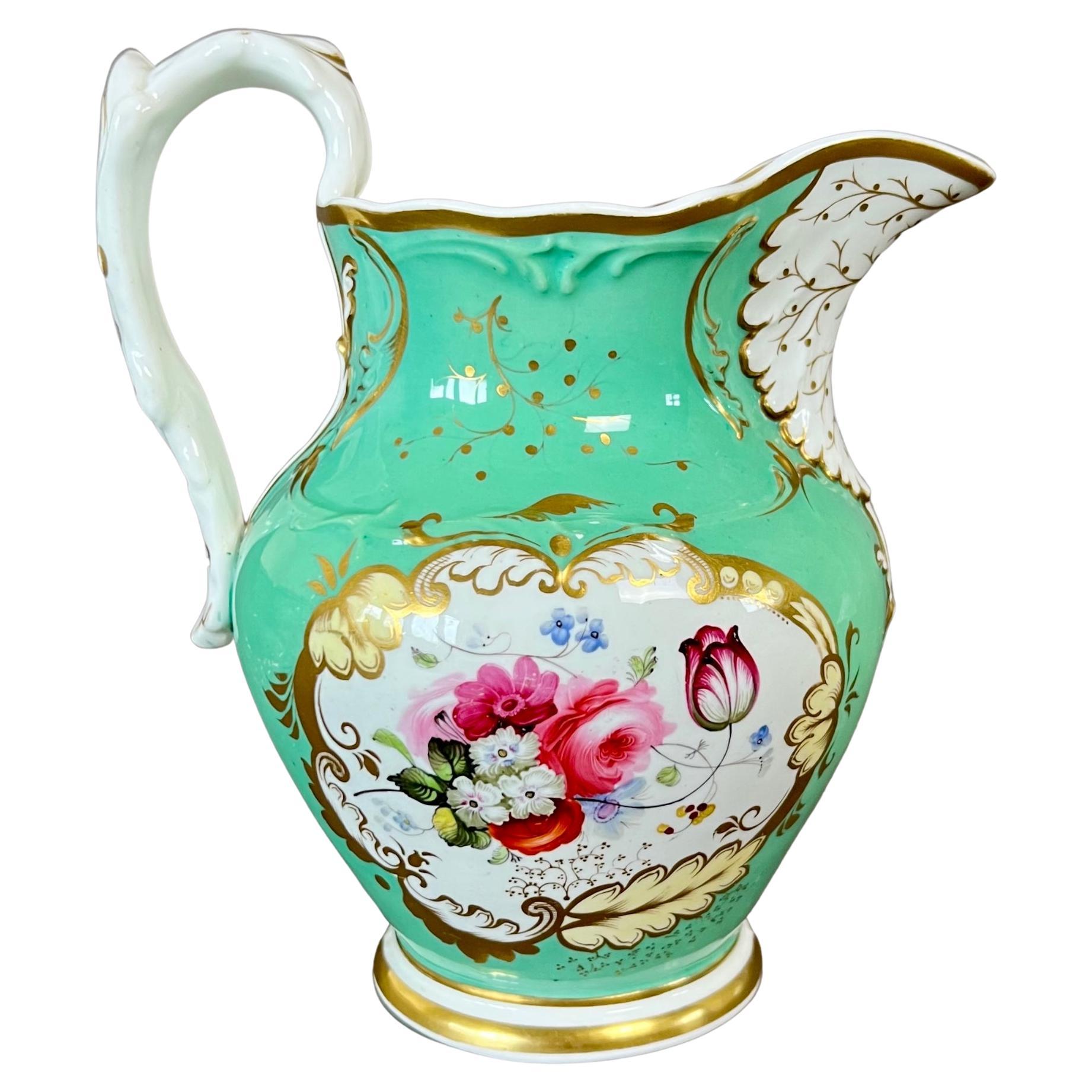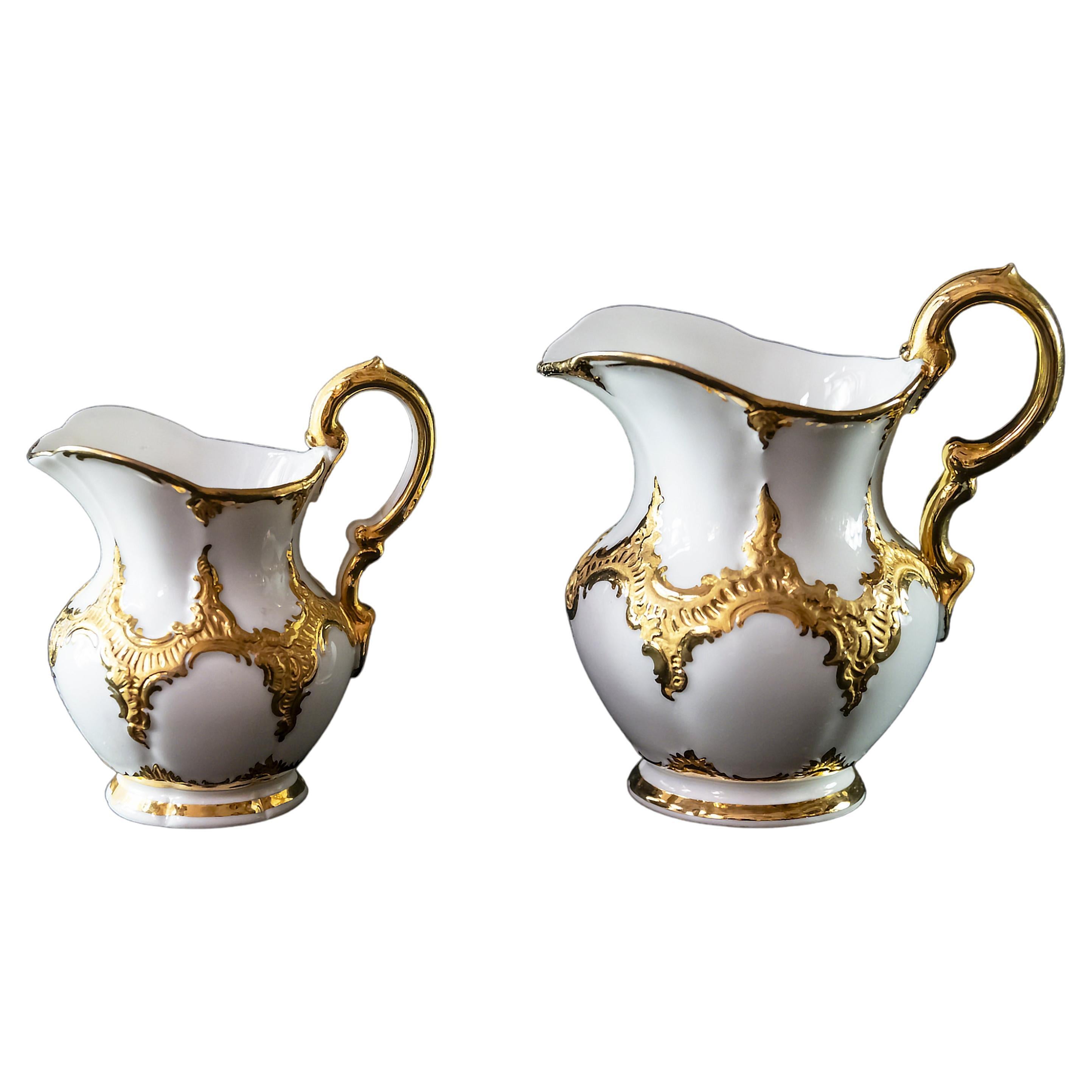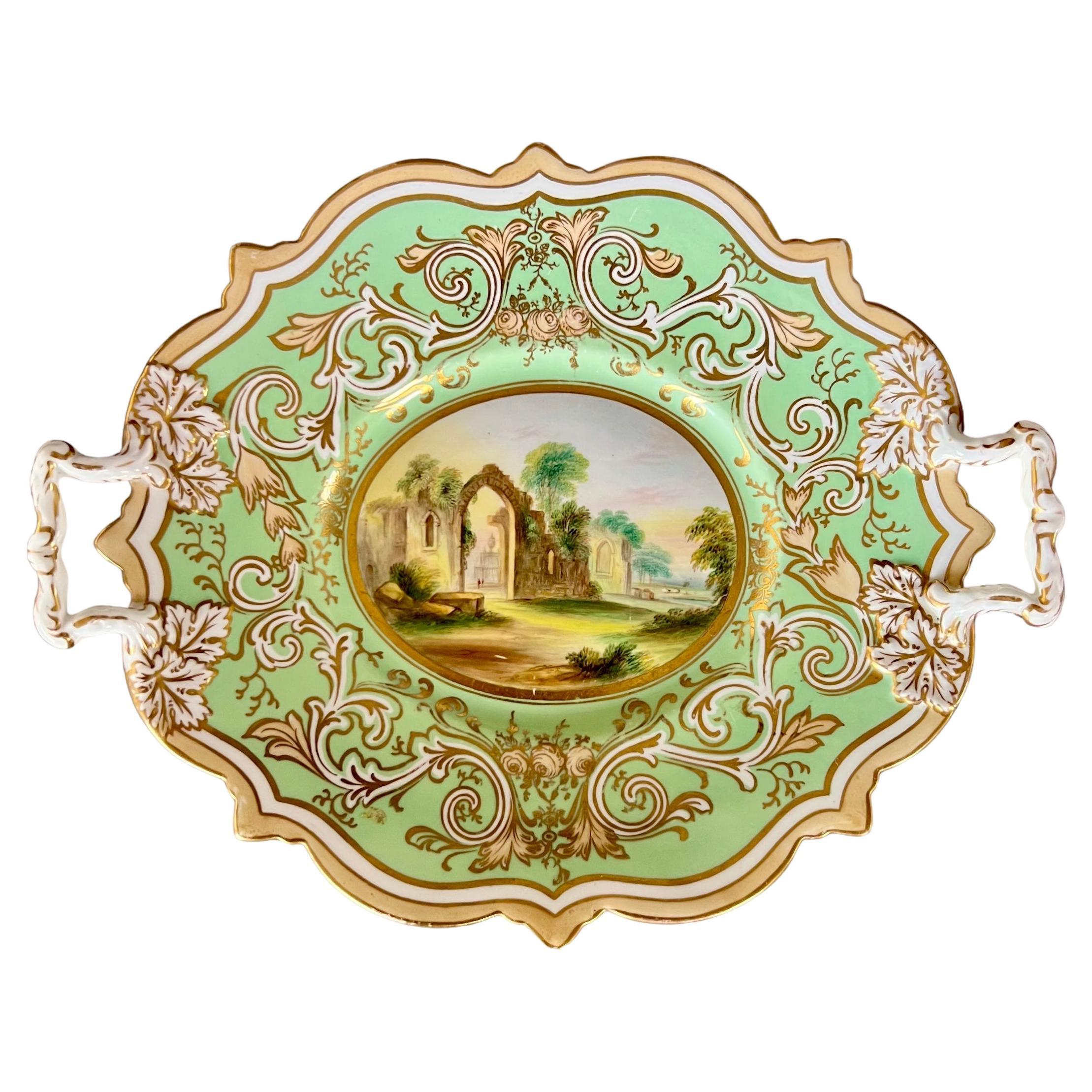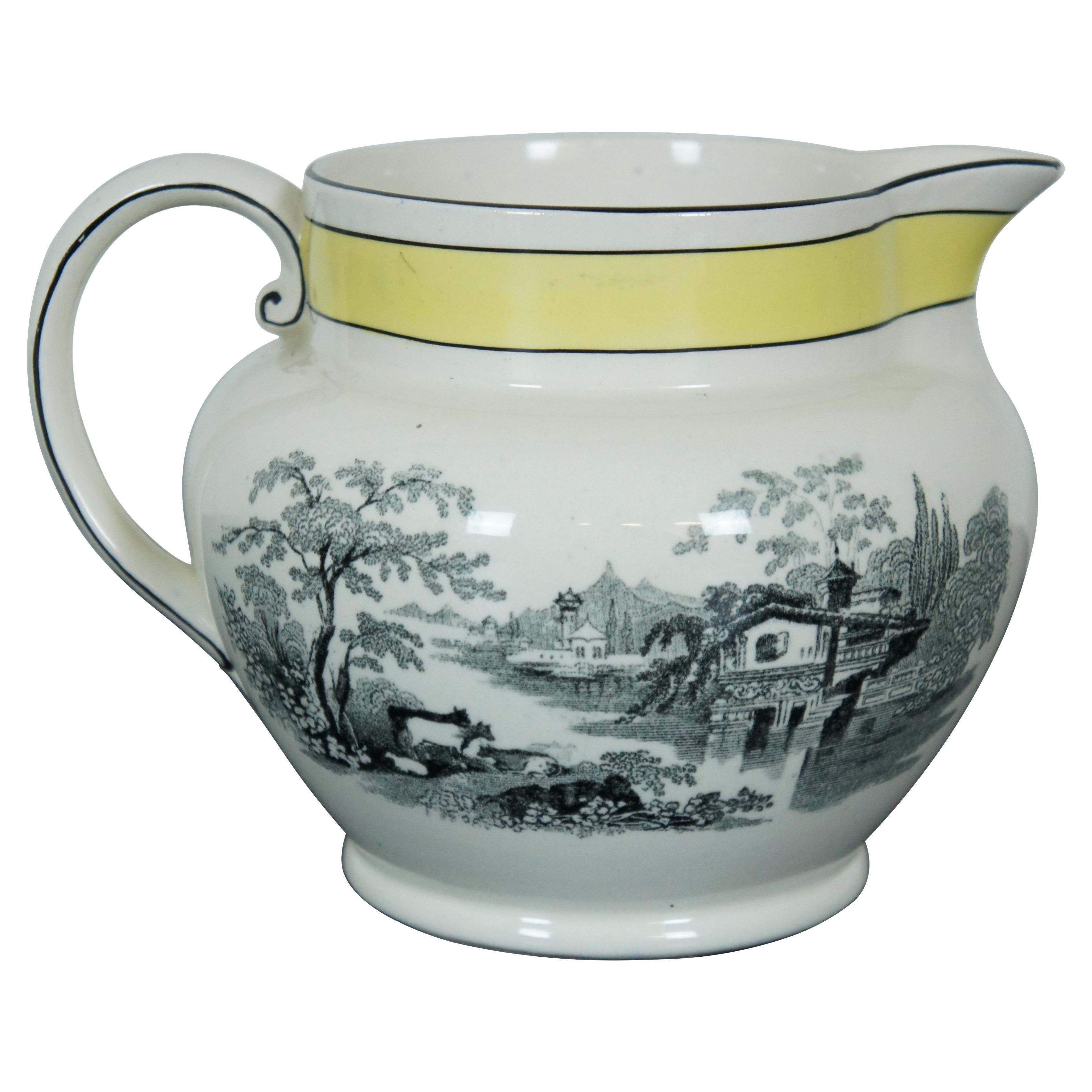Items Similar to Samuel Alcock Cream Jug, Pitcher, Eau de Nil with Jay and Landscape, 1854
Want more images or videos?
Request additional images or videos from the seller
1 of 13
Samuel Alcock Cream Jug, Pitcher, Eau de Nil with Jay and Landscape, 1854
About the Item
A cream or water jug / pitcher with elegant scrolled moulding, an eau de nil ground colour with yellow and gilt leafy scrolls, with a jay on one face and a landscape on the other
Pattern unknown
Year: 1854
Size: 143m (5.1”) from handle to mouth, 14cm (5.75”) tall
Condition: a crack in the top of the handle with associated line in the body, some crazing but the jug is stable and good for use
The Samuel Alcock factory was operative in Staffordshire between 1822 and 1856, after which it was bought by Sir James Duke and Nephews. The factory started as a partnership between the young Samuel Alcock and the older Ralph Stevenson, who provided the factory and capital. Alcock quickly took the factory to great heights, building one of the biggest factories of its time. Alcock jumped on the new Rococo Revival fashion and served a huge new middle class market. The reason we now don't hear much about Samuel Alcock porcelain is that much of it has been mis-identified over the years and attributed to Coalport, Ridgway, Rockingham or others; Alcock did not mark any of his porcelain save a few rare pieces, and the numbering system is difficult to understand. However, the wares are still wide spread and many are of great quality.
This jug forms part of the Murray Pollinger Collection of Samuel Alcock Porcelain. Most of the collection is not publicly available yet, but if you would like to get access to the first 100 lots, please sign up for our mailing list at the bottom of this page, and we will send you the full catalogue with more information, from which you can purchase more items.
Murray Pollinger was a passionate collector of Samuel Alcock porcelain. He was known as a true gentleman, impeccably dressed, always kind and modest - even some of his porcelain collecting friends had no idea about the size and importance of his collection. From the mid 1980s until shortly before his death in 2022 he collected many thousands of pieces and painstakingly catalogued them. He also went on trips to Staffordshire to discover the history of Samuel Alcock from whatever little documentation has been preserved. Through his painstaking work, Pollinger was able to make sense of the pattern numbering system that was used, and this was a huge step forward in identifying and understanding the porcelain. A website with the results of his research will be made available over the course of 2023. While he sold off about half of his collection in 2016, the remaining half is now made available to a new generation of collectors.
Antique British porcelain is never perfect. Kilns were fired on coal in the 1800s, and this meant that china from that period can have some firing specks from flying particles. British makers were also known for their experimentation, and sometimes this resulted in technically imperfect results. Due to the shrinkage in the kiln, items can have small firing lines or develop crazing over time, which should not be seen as damage but as an imperfection of the maker's recipes, probably unknown at the time of making. Items have often been used for many years and can have normal signs of wear, and gilt can have signs of slight disintegration even if never handled. I will reflect any damage, repairs, obvious stress marks, crazing or heavy wear in the item description but some minor scratches, nicks, stains and gilt disintegration can be normal for vintage items and need to be taken into account.
There is widespread confusion on the internet about the difference between chips and nicks, or hairlines and cracks. I will reflect any damage as truthfully as I can, i.e. a nick is a tiny bit of damage smaller than 1mm and a chip is something you can easily see with the eye; a glazing line is a break in the glazing only; hairline is extremely tight and/or superficial and not picked up by the finger; and a crack is obvious both to the eye and the finger. Etcetera - I try to be as accurate as I can and please feel free to ask questions or request more detailed pictures!
- Creator:Samuel Alcock & Co. (Maker)
- Dimensions:Height: 1 in (2.54 cm)Width: 1 in (2.54 cm)Depth: 1 in (2.54 cm)
- Style:Victorian (Of the Period)
- Materials and Techniques:
- Place of Origin:
- Period:
- Date of Manufacture:1854
- Condition:Wear consistent with age and use. crack in the top of the handle with associated line in the body, some crazing but the jug is stable and good for use.
- Seller Location:London, GB
- Reference Number:
About the Seller
5.0
Platinum Seller
These expertly vetted sellers are 1stDibs' most experienced sellers and are rated highest by our customers.
Established in 2016
1stDibs seller since 2019
208 sales on 1stDibs
Typical response time: 1 hour
- ShippingRetrieving quote...Ships From: London, United Kingdom
- Return PolicyA return for this item may be initiated within 14 days of delivery.
More From This SellerView All
- Samuel Alcock Cream Jug Pitcher, Pale Green with Flowers and Landscape, ca 1840By Samuel Alcock & Co.Located in London, GBA cream or water jug / pitcher with knobbed twig handle and moulded foliage under the beak, decorated in a pale green ground with a finely painted landscape on one side and rich flow...Category
Antique 1840s English Victorian Pitchers
MaterialsPorcelain
- Samuel Alcock Teacup Trio, Yellow with Fine Romantic Landscapes, ca 1845By Samuel Alcock & Co.Located in London, GBA true trio consisting of a teacup, a coffee cup and a saucer, “rustic bean” shape, in beautiful yellow pattern with acanthus leaves and very finely painted romantic landscapes with ...Category
Antique 1840s English Victorian Tea Sets
MaterialsPorcelain
- Samuel Alcock Low Oval Comport Dish, Sage Green with Landscape, ca 1850By Samuel Alcock & Co.Located in London, GBAn oval low-footed comport with two handles and an octagonally scrolled shape, a moulded surface with pale yellow and white scrolling foliage on a sage green ground, and a stunning l...Category
Antique 1850s English Victorian Serving Bowls
MaterialsPorcelain
- Samuel Alcock Teacup and Milk Jug, Pale Yellow, Gilt and Flowers, ca 1824By Samuel Alcock & Co.Located in London, GBA teacup and saucer with milk jug in the “melted snow” shape with double drop handles, pale yellow ground with rich gilt and cobalt blue acanthus pattern and finely painted flower re...Category
Antique 1820s English Regency Tea Sets
MaterialsPorcelain
- Samuel Alcock Porcelain Vase, Maroon with Landscapes, Rococo Revival, ca 1840By Samuel Alcock & Co.Located in London, GBOn offer is a beautiful porcelain vase made by Samuel Alcock circa 1840 during the Rococo Revival era. It has a maroon ground and a stunning landscape painting. Samuel Alcock was on...Category
Antique 1840s English Rococo Revival Vases
MaterialsPorcelain
- Samuel Alcock Griffin Vase, Cobalt Blue with Landscapes, Rococo Revival, ca 1840By Samuel Alcock & Co.Located in London, GBOn offer is a beautiful porcelain vase made by Samuel Alcock in about 1840 during the Rococo Revival era. The vase has griffin-shaped handles, a cobalt blue ground, lavish gilt and a...Category
Antique 1840s English Rococo Revival Vases
MaterialsPorcelain
You May Also Like
- Set of 2 pcs. German Meissen Porcelain Cream and Milk Pitchers / JugsBy Meissen PorcelainLocated in Vilnius, LTSet of 2 pcs. of German Meissen porcelain cream and milk pitchers / jugs. Porcelain is white, glazes and hand painted with rich gold decor. The logo marked on the bottoms. Dimensions...Category
Mid-20th Century German Porcelain
MaterialsGold
- Antique English Staffordshire Transferware Serving Creamer Jug PitcherLocated in Dayton, OH"Antique 20th century Staffordshire transferware porcelain jug or pitcher featuring an English landscape in black, originally designed by James Cutts for W. Adams & Sons, and a yellow border around the upper edge. “James Cutts was born in 1808 in Pinxton, Derbyshire, he was the 9th of 10 children and the youngest of five boys. His father, John Cutts, was a moderately gifted china painter, trained at the Derby porcelain works, who moved to become manager of the Pinxton porcelain...Category
Early 20th Century Late Victorian Porcelain
MaterialsPorcelain
- Antique English Caughley Porcelain Milk Pitcher or JugBy Caughley PorcelainLocated in Philadelphia, PAA fine antique English porcelain milk pitcher or jug. Comprising the pot, a conforming lid, and a later associated chain connecting the two. With blue underglaze decoration of...Category
Early 20th Century English Georgian Pitchers
MaterialsPorcelain
- English Porcelain Cream Jug, Longton Hall, 1755Located in New York, NYModelled in the form of overlapping vine leaves, the interior of the spout painted with a sprig of yellow flowers and the twig handle issuing two small clusters of purple grapes.Category
Antique 1750s English Pitchers
MaterialsPorcelain
- Contemporary Hand-Painted Porcelain 2 Pint Jug Pitcher, Made in ItalyBy Coralla MaiuriLocated in Roma, RM“I have been creating artworks and installations for a long time. Then over the past several years, pottery has absorbed most of my expressive energy. I follow an empirical, yet intu...Category
2010s Italian Pitchers
MaterialsPorcelain
- Contemporary Hand Decorated Porcelain 2 Pint Jug Pitcher, Made in ItalyBy Coralla MaiuriLocated in Roma, RM“I have been creating artworks and installations for a long time. Then over the past several years, pottery has absorbed most of my expressive energy. I follow an empirical, yet intu...Category
2010s Italian Pitchers
MaterialsPorcelain
Recently Viewed
View AllMore Ways To Browse
Antique Chinese Water Jug
Chinese Water Jug
Antique Glass Pitcher With Silver
Antique Porcelain Cream Jugs
Wide Mouth Pitcher Silver
Eye Glasses Rare
Chinese Glass Fired Signs
Vintage Sterling Silver Pitchers
Meriden Silver Water Pitcher
Orange And Amber Pitcher Glass Vase
Staffordshire Dog Pitcher
Vintage Hobnail Pitcher
W Adams Pitcher
Waterford Crystal Pitcher
Antique Cow Pitcher
Antique Sexton
Danish Silver Tankard
Kaj Franck Carafe





